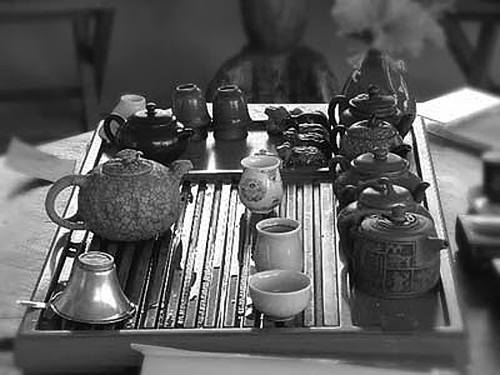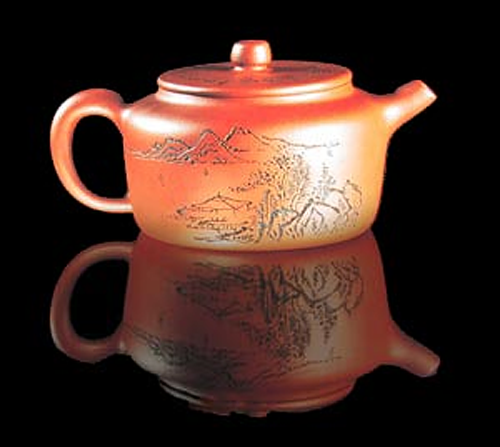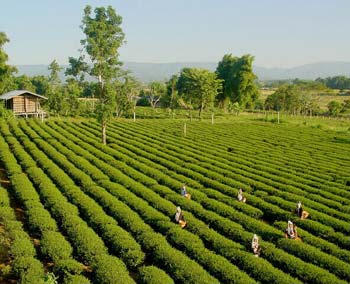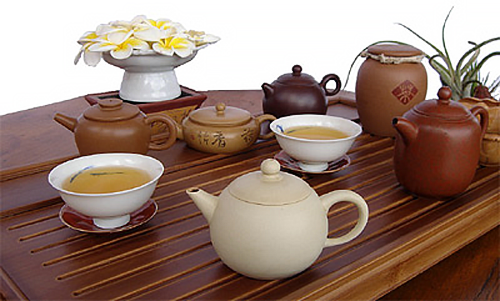By Daniel Reid
Bestselling author & leading expert on eastern philosophy, Taiwanese tea & TCM.
Tea, tea pots, and the fine art of preparing tea are one of China's greatest and most enduringly popular contributions to world civilization. Among the many varieties of Chinese tea available on the market today, there is one whose fragrance and flavor surpass all others and make it stand out among teas "like a crane among chickens," as the Chinese would say.
Oolong (Black Dragon) Tea
This peerless distinction belongs to a noble variety of Oolong ("Black Dragon") tea known as High Mountain Oolong Tea (gao-shan oo-long cha), which early Chinese settlers brought from mainland China to Taiwan during the late 17th century.

Over the centuries, Chinese planters in Taiwan's mountainous central highlands meticulously cultivated this special variety of tea to produce what sophisticated connoisseurs of Chinese tea today regard as the finest tea on earth, the ultimate masterpiece in the Chinese art of tea.
High Mountain Oolong
High Mountain Oolong is a semi-fermented tea which retains all of the nutrients and natural healing factors contained in unfermented green tea, but without the "raw" grassy taste and harsh impact on the stomach that make green tea disagreeable to most people. The very brief fermentation process eliminates harsh irritants from the raw tea and creates the subtle fragrances and flavors which distinguish this tea from all other varieties, without producing the tannins and other toxic compounds found in fully fermented black tea.
The cultivation and appreciation of High Mountain Oolong is somewhat similar to fine wine, with each plantation and each mountain producing its own unique bouquet of flavors, and each year's harvest yielding its own special character.

Once you've tasted a fine grade of High Mountain Oolong, properly prepared the traditional Chinese way, you will know exactly what makes it so special. This tea delivers a bouquet of flavors that clearly speaks for itself the moment it touches your tongue and wafts through your nose, creating tastes and after-tastes, tones and over-tones, that cannot be faked or imitated by less well bred teas.
A sip of freshly poured High Mountain Oolong introduces itself quietly in the mouth with a dry, slightly astringent foretaste which instantly clears the palate of all other residual flavors. As soon as the sip is swallowed, its marvelous floral aftertaste blooms quickly on the tongue and expands aromatically into the throat and sinuses, unfolding like the fumes of a fragrant flower.
This is a very hard act for any other tea to follow, and many tea drinkers become lifelong devotees of High Mountain Oolong after trying it for the first time.
The Art of High Mountain Oolong
Equally important as the quality of the tea is the Chinese art of properly preparing and appreciating High Mountain Oolong. Small unglazed clay teapots hand-crafted by master potters are used to steep this type of tea, and these are highly treasured collectors items among dedicated drinkers of High Mountain Oolong. Connoisseurs also collect tea cups and tea caddies, tea scoops and tea trays, and other requisite paraphenalia of the ancient art.
Unlike the stiff formality of the Japanese tea ceremony, in which every move is ritualized and the quality of the tea itself is not very important, the Chinese art of tea focuses entirely on the practical points of savoring the flavor and fragrance of the tea, enjoying the touch and utility of the tea tools, and engaging in the spontaneous exchange of thoughts and feelings which drinking this tea together always inspires among fellow tea drinkers.
In fact, the Chinese refer to devoted connoisseurs of fine tea as cha ren, literally "tea people," as though they were a unique breed, which indeed they are. There are so many subtle facets to the Chinese art of tea, and particularly High Mountain Oolong Tea, that it takes a lifetime to master them all, but basically it's the expression of a whole way of life, a way that harmonizes the various elements of nature in a balanced, aesthetically pleasing manner that refreshes the body, soothes the mind, and delights the spirit. The Venerable Popchong Sunim of Korea, who cultivates the art of tea as part of his spiritual cultivation, describes the proper appreciation of tea as follows:
To determine whether a tea is good or not, one should examine the color, scent, and taste of the infusion. The perfect color is that of the first leaves in spring; the scent is like that of a young baby. The taste cannot be described but can be appreciated with experience. Tea is drunk to quench the thirst, savor the taste, or simply to spend a quiet hour appreciating the pottery and the general atmosphere that accompanies tea drinking. There is no need to have a special attitude while drinking it, except one of thankfulness.

The traditional method of preparing and drinking High Mountain Oolong Tea has been developed to perfection in Taiwan, where it's known as cha yi ("tea art") which reflects the two essential elements required to properly appreciate High Mountain Oolong: taste and time. A unique technique in the classical way of preparing this tea is the preliminary "hot bath," whereby hot water is poured onto the dry leaves in the pot and immediately poured out and discarded. This step washes the tea leaves and eliminates all residual traces of dust, oxidation, smog, fumigants, and any other contaminants to which the tea may have been exposed during processing, thereby guaranteeing pure flavor and natural fragrance with each subsequent infusion.
Health Benefits of High Mountain Oolong Tea
In addition to its value as an epicurean and aesthetic experience, High Mountain Oolong Tea also has potent medicinal benefits and is an excellent elixir for health and longevity.
Long known in traditional Chinese medicine for its detoxifying and digestive virtues, this tea has been proven by recent scientific research in Japan to have powerful cleansing and protective properties for the lungs. This effect is produced by the volatile aromatic fumes which give this tea its distinctive fragrance and flavor. As gases suspended within the fluid of the tea, these aromatic elements are excreted from the bloodstream through the lungs, not the kidneys, and as they pass through the delicate lung tissues with each exhalation, they dislodge heavy metals, tars, and other toxic residues from the alveoli (air sacs) and bronchia, allowing the toxins to be coughed up and spit out.
As a result of this discovery, High Mountain Oolong has become the beverage of choice for millions of Chinese and Japanese people, who rank among the world's heaviest smokers. Studies have shown that smokers who drink this tea throughout the day have significantly lower rates of lung cancer, emphysema, and other respiratory ailments than those who don't.
High Mountain Oolong Tea also has many other health benefits, and these have all been validated by modern scientific research. The most important therapeutic advantages derived from drinking this tea on a daily basis are briefly discussed below:
Antioxidant
High Mountain Oolong contains abundant supplies of potent antioxidants known as "polyphenols" and "catechins." These compounds, also known as "free radical scavengers," neutralize and eliminate the highly reactive metabolic and environmental toxins known as "free radicals," which destroy cells, corrode tissues, and cause premature degeneration of the internal organs. The antioxidants in the tea provide constant detoxifying activity in the blood and tissues, protecting the body from toxic damage and preventing formation of tumors.
Anti-Cancer
Since the polyphenols and other antioxidants contained in High Mountain Oolong suppress tumor formation, drinking this tea daily provides strong protection against the development of all types of cancer, particularly in the lungs and liver, which suffer the heaviest exposure to toxic contaminants in air, water, and food. This protection against cancer is further enhanced by the tea's strong alkalizing action in the blood and tissues, where it counter-acts the excessive acidity associated with all forms of cancer.
Scientists already know green tea plays a role in preventing cancer, but now they know why: EGCG, or Epigallocatechin gallate. EGCG works in precisely the same way as the chemotherapy drug methotrexate: Both hinder the action of an enzyme that incites cells to divide, according to Spirituality Health (July/August 2005). Since EGCG causes less damage to healthy cells than chemotherapy, it could become a promising cancer treatment. High Mountain Oolong has even more potent anti-cancer properties than green tea, and unlike green tea, it can be drunk continuously throughout the day for maximum therapeutic benefits.
Alkaline
High Mountain Oolong alkalizes the digestive tract, bloodstream, and cellular fluids, neutralizing the acidity which permits formation of cancerous tumors and causes many other degenerative conditions. Blood and tissue acidity is the primary cause of loss of calcium from the bones and teeth, and this in turn leads to osteoporosis and tooth decay. Drinking this tea daily therefore helps prevent these conditions as well as other health problems associated with calcium deficiency.
Diuretic
The tea's mild diuretic properties promote swift elimination of the toxins and acid wastes flushed from the blood and tissues by the antioxidant and alkaline elements in the tea.
Deodorant (Breath Freshener)
By alkalizing the mouth and stomach, this tea eliminates the bacteria responsible for producing foul odors in the breath. The aromatic fumes contained in the tea saturate the blood and bodily fluids with cleansing medicinal elements that help deodorize bodily secretions.
Blood Adaptogen
High Mountain Oolong contains medicinal factors known as "adaptogens," which adapt the body's vital functions to changing conditions in order to maintain a healthy state of equilibrium. This balancing effect is strongest in the bloodstream, where it regulates blood pressure, balances blood sugar, and prevents thickening of the blood. Digestive: High Mountain Oolong assists digestion by neutralizing excess acidity and preventing fermentation and putrefaction in the stomach. It also breaks down fat molecules into smaller particles, making them much easier to digest.
Detoxificant
Drinking this tea daily produces a continuous detoxifying effect throughout the body, facilitating the elimination of metabolic wastes and toxic residues assimilated from food, air, and water.
Cholesterol Control
Studies have shown that High Mountain Oolong Tea removes cholesterol deposits and other sticky plaque from the walls of the blood vessels, thereby preventing arteriosclerosis, heart disease, and strokes.
Mild Stimulant
This tea contains only around 0.5% caffeine but also several other compounds and co-factors which have mild stimulating effects on the central nervous system. Unlike coffee, which stimulates the body by racing the heart, the blend of natural stimulants in High Mountain Oolong Tea directly activates the nervous system, enhancing alertness, improving cerebral functions, and relieving mental fatigue. They also stimulate swift elimination of wastes from the body. Due to the many nutrient co-factors contained in this tea, the stimulation it provides does not enervate the nervous system, as coffee and black tea can do, and its stimulating properties may be enjoyed throughout the day without any negative side-effects.
Nutrient
High Mountain Oolong contains significant amounts of vitamins A, C, and E, as well as essential minerals and trace elements. These nutritional factors all have potent antioxidant and healing properties, providing additional support for detox and immune responses and increasing the health benefits of the tea.
Antiseptic
By producing a clean alkaline environment in the body, this tea destroys a wide range of bacteria, fungus, and other microbes, most of which depend on toxic acid conditions in the blood and tissues in order to survive and spread in the human body.
High Mountain Oolong Tea From Taiwan

Today, the top grades of High Mountain Oolong Tea from Taiwan rank among the most expensive and highly prized teas in the world, with prices ranging as high as US$800 per "catty," or "Chinese pound," equivalent to 600 grams. While fairly good grades of High Mountain Oolong grown from Taiwan tea plants by Chinese planters in Thailand and Vietnam are also available on the market today at lesser cost, the best grades of this aromatic tea can only be found in Taiwan.
As this tea becomes better known throughout the world for its unsurpassed flavor and potent protective health properties, demand continues to drive up the cost of limited supplies of the best quality harvests. Nevertheless, since the top grades of this tea are not only the best tasting but also the most therapeutically beneficial, it's never a waste of time to sit down each day to prepare and drink it properly, nor is it ever a waste of money to buy the best quality you can afford.
For those who cultivate the Chinese art of tea, cha dao ("The Way Of Tea") soon becomes a whole way of life . The process of preparing and appreciating High Mountain Oolong Tea the traditional way develops a personal refinement and discriminating taste that gradually influence and improve every other aspect of daily life and awaken the mind to subtle nuances of nature that formerly went unnoticed. All of the human senses are pleased by the art of tea, which embraces the most basic elements of nature--earth, water, fire, wood, air--in a harmonious interplay of energies that produces the perfect cup of tea and establishes the perfect state of mind to appreciate its virtues.
In his excellent book, The Chinese Art of Tea, the sinologist John Blofeld describes the aesthetic and philosophical appeal of drinking this sort of tea the Chinese way:
One should recognize that drinking tea is something in itself, to be done for its own sake and not to fulfill an ulterior purpose, for only in this way can the drinker come to "taste sunlight, wind, and clouds."
This is a typically Taoist and Zen sentiment. Tea, unlike powerful drugs or alcohol, increases rather than dulls alertness and carries with it the essence of sunlight and mist, the spirit of sparkling mountain springs and a pleasant earthy tang.
Tea mysteriously engenders empathy with nature and kinship with one's fellow beings.

But be forewarned: once you develop a taste for good High Mountain Oolong Tea, you will lose your taste for all other types of tea, as well as coffee, and after you start collecting tea pots and cultivating the Chinese art of tea, other hobbies will lose much of their appeal, and the Way of Tea will become a new way of life.

